Assessment of Zooplankton Community in the Kagina River Dam Kachur, Sedam Taluk, Kalaburagi District, Karnataka
1
Department of P.G. Studies and Research in Zoology,
Sharnbasva University,
Kalaburagi,
Karnataka
India
Corresponding author Email: poojari.glb@gmail.com
DOI: http://dx.doi.org/10.12944/CWE.19.1.35
Copy the following to cite this article:
Poojari S. L, Kottalagi S, Kollur C. Assessment of Zooplankton Community in the Kagina River Dam Kachur, Sedam Taluk, Kalaburagi District, Karnataka, India.Curr World Environ 2024;19(1). DOI:http://dx.doi.org/10.12944/CWE.19.1.35
Copy the following to cite this URL:
Poojari S. L, Kottalagi S, Kollur C. Assessment of Zooplankton Community in the Kagina River Dam Kachur, Sedam Taluk, Kalaburagi District, Karnataka, India.Curr World Environ 2024;19(1).
Download article (pdf) Citation Manager Publish History
Select type of program for download
| Endnote EndNote format (Mac & Win) | |
| Reference Manager Ris format (Win only) | |
| Procite Ris format (Win only) | |
| Medlars Format | |
| RefWorks Format RefWorks format (Mac & Win) | |
| BibTex Format BibTex format (Mac & Win) |
Article Publishing History
| Received: | 2023-11-01 |
|---|---|
| Accepted: | 2024-05-08 |
| Reviewed by: | 
 Neel Rajendrakumar Talati
Neel Rajendrakumar Talati
|
| Second Review by: |

 Devangee P. Shukla
Devangee P. Shukla
|
| Final Approval by: | Dr. S K Dash |
Introduction
Zooplankton are small, primarily microscopic, and often drifting aquatic organisms that form a crucial component of the plankton community in various aquatic ecosystems. In the aquatic food chain, zooplankton play a important job by transporting energy to larger aquatic organisms such as fish and other higher trophic levels from primary producers like phytoplankton. Zooplankton is a useful marker of alterations in water quality because they react fast to changes in water quality and are greatly impacted by environmental factors 1 and in freshwater ecosystems, these play a crucial role in aquatic food webs and greatly increases aquatic productivity 2, further, these have essential function and acts as bioindicators, making it a useful tool for determining the level of water pollution 3.Since, zooplankton sensitive to changes in the aquatic water body and deviation in their composition may result in significant change in ambient condition within aquatic system 4. An excellent method for evaluating biotic potential is zooplankton research, which also helps to estimate the general economic potential and fundamental characteristics of water bodies5 and 6.
Several researchers have assessed the tropical condition of aquatic ecosystems using various zooplankton groupings. Notable scientists who have thoroughly examined several facets of zooplankton include 7, 8, 9, 10, 11, 12 and 13.However, there is a lack of information about the zooplankton of the Kagina River Dam Kachur. Thus, the primary objective of this research is to assess the Zooplankton community in Kagina River Dam Kachur.
Materials and methods
Study area
Kachur is a small village in Sedam Taluk in Kalaburagi District of Karnataka state, India. Kachur Dam is located near to the two adjoining villages namely Kachur and Biballi Sedam Taluk. There are five sampling stations are selected namely Kachur station I, Kachur station II, Kachur station III and Kachur station IV (Table.1).Kagina River Dam Kachur is a fresh water body located 500 m away from Kachur village. It lies between latitude and longitude of 170.22’ North and 770.28’ East respectively. The primary use for this body of water is agriculture. Water is also utilized for household chores and other human activities. The map of study area is shown in figure No.1and 2. The maps and graphs are prepared by using Microsoft Paint and Excel.
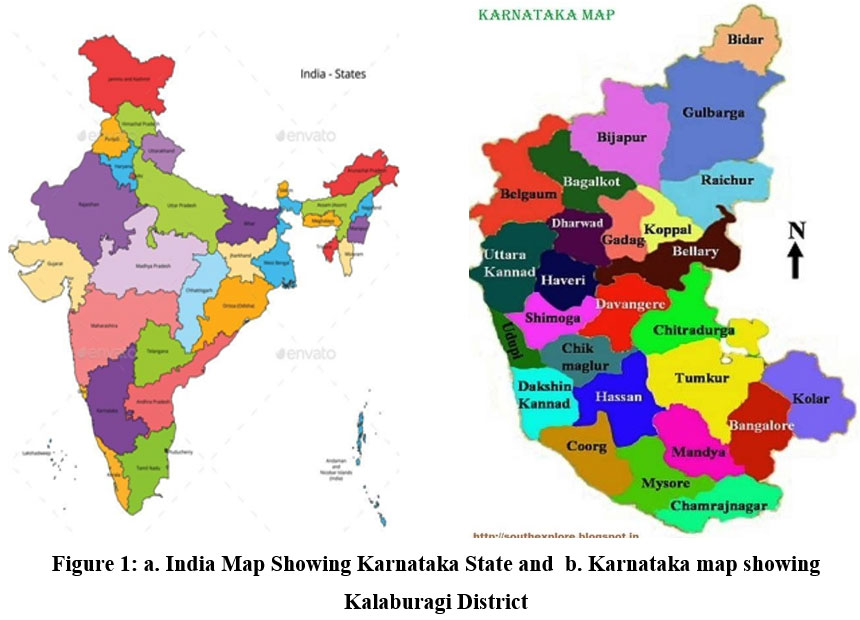 | Figure 1: a. India Map Showing Karnataka State. and b. Karnataka map showing Kalaburagi District
|
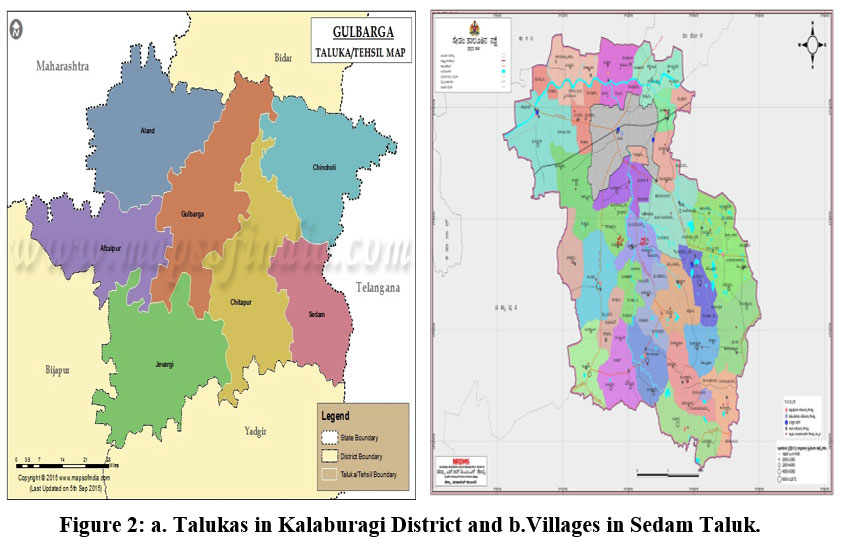 | Figure 2: a. Talukas in Kalaburagi District. and b.Villages in Sedam Taluk.
|
Collection and identification of Zooplankton
The water samples were collected on the monthly basis from Kachur dam for the period of one year, from October 2022 to September 2023. The zooplankton was collected using a nylon bolting silk plankton net (No. 25, mesh size 50 ?) that served as the filtering cone. Ten meters was the distance the net was dragged. Samples that had been collected were put into vial bottles with labels and 4% formalin. The area of the net's mouth was multiplied by the reservoir's depth to get the volume of filtered water. Following sedimentation, 100 milliliters of the sample are centrifuged for 20 minutes at 1,500 rpm in order to be used for additional research. As stated by Needham 14. Standard keys Pennak 15, Tonapi 16, and 17 are used to identify zooplankton using standard literature up to the generic level. As per the protocols provided by APHA 18. For both qualitative and quantitative analysis of planktons Sedgwick Rafter Cell was used.
Results and discussion
Results
Twenty species of zooplankton, representing fourteen genera, eight families, and five orders, were identified based on the results of the current study. These species are classified into three groups: Rotifera, Cladocera and Copepod. Among these three groups Rotifera was the dominant one. The results are shown in the Table No. 1, 2, 3and Figure No. 3, 4, 5 and 6.
Out of 20 species, Rotifera comprises 8 species five genus i.e. Anueropsis fissa, Asplanchanidae species, Brachionus calyciflorus, Brachionus plicatilis, Brachionus rotundiformis, Brachionus urceolaris, Lecane luna and Lepadella bicornisbelonging to four Family and one Order, respectively. Among these Brachionus calyciflorusis dominant in the all the sites.
Seasonally the number was highest in premonsoon i.e 600/L followed by monsoon 420/L and lowest during post monsoon 300/L.
Cladocera comprises of 6 species four genus i.e.Ceriodaphnia cornuta, Ceriodaphnia dubia, Daphnia carinata, Moina micrura, Moina species and Simocephalus vetulus belonging to two order, two family, respectively. According to observation Daphnia carinata species is dominant.
Seasonally the number was highest in pre monsoon i.e 390/L followed by monsoon 300/L and lowest during post monsoon 210/L.
Copepoda comprises 6 species five genus i.e. Cyclopoid nauplius, Cyclop species, Heliodiaptomus viduus, Mesocyclops leukarti, Neodiaptomus strigilips and Tropocyclops prasinus belonging to two order, two families and respectively. Among these Mesocyclops leukarti species are very commonly found during investigation.
Seasonally the number was highest in pre monsoon i.e 450/L followed by monsoon 315/L and lowest during post monsoon 200/L.
Discussion
Rotifera
Eight species of rotifers were identified in the current investigation representing 1 order 4 families and 5 genus. Rotifers have been found to be the dominant group over the duration of the investigation. Due to its small size, rapid reproduction, adaptability, resilience to adverse conditions, and versatile feeding habits of rotifers makes them well-suited to dominate in this freshwater body and Rotifer dominance was also attributed to the presence of alga in the pond19.They play essential roles in nutrient cycling and the food web dynamics of these ecosystems. Seasonal variation showed that the number was high in pre monsoon, it might be the presence of food (phytoplankton) in the water body and the favorable environmental conditions may be responsible and low in winter it could be caused by a high level of turbidity and poor light. Comparable findings were given by earlier workers 2, 20, 21, 22, 23, 24 and 25.
Cladocera
Six cladocera species were identified in the current investigation representing 2 order 2 families and 4 genus.. Seasonal variation showed that the number was high in pre monsoon and low in winter. This is due to the one of the most significant abiotic variables affecting zooplankton distribution and abundance is temperature. The main factors influencing the Cladocerans are temperature, food supply, and water turbidity [21]. Similar results were given by various researchers 26, 27, 28, 29, and 30 .
Copepoda
Six copepode species were identified in the current investigation representing 2 order 2 families and 5 genus. Seasonal variation showed that the number was high in pre monsoon and low in winter. This may be due to high temperature and increased water evaporation, which results in a concentrated density of producers. As a result, there is more food available for zooplanktons.
Similar observations are made by 26,13, 30, 31 and 32 reported that, the temperature, turbidity, rate of reproduction and wind altogether influence on the distribution and variation of copepoda population.
Table 1: Group wise variation in Zooplankton species in Kagina River Dam Kachur, Sedam Taluk, Kalaburagi District.
Sl. No | Zooplankton groups | Species | Sampling stations | |||
I | II | III | IV | |||
1 | Rotifera | Anueropsis fissa | + | - | + | + |
Asplanchanidae species | + | + | + | - | ||
Brachionus calyciflorus | + | + | + | + | ||
Brachionus plicatilis | - | + | + | + | ||
Brachionus rotundiformis | + | - | + | + | ||
Brachionus urceolaris | - | + | + | + | ||
Lecane luna | + | + | - | + | ||
Lepadella bicornis | + | + | + | - | ||
2 | Cladocera | Ceriodaphnia cornuta | - | + | - | + |
Ceriodaphnia dubia | - | - | + | + | ||
Daphnia carinata | + | + | + | - | ||
Moina micrura | + | - | - | + | ||
Moina species | - | + | + | - | ||
Simocephalus vetulus | + | + | - | - | ||
3 | Copepoda | Cyclopoid nauplius | - | + | - | - |
Cyclop species | + | - | - | - | ||
Heliodiaptomus viduus | - | - | + | - | ||
Mesocyclops leukarti | - | + | - | + | ||
Neodiaptomus strigilips | + | - | - | - | ||
Tropocyclops prasinus | - | - | + | - | ||
Total | 11 | 12 | 12 | 10 | ||
 | Figure 3: No of Zooplankton species reported at different sampling sites.
|
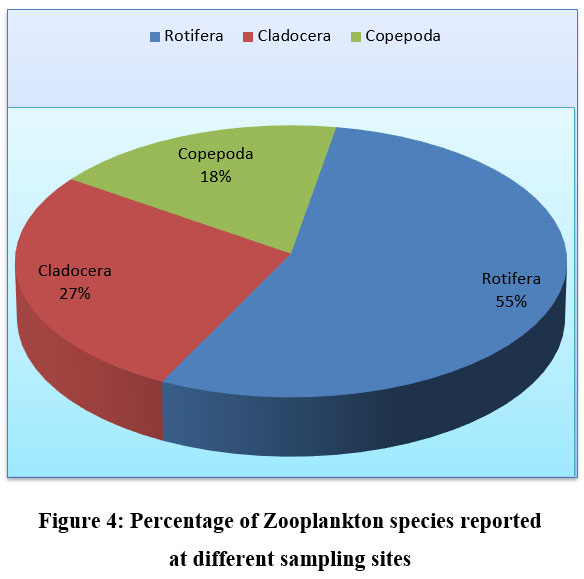 | Figure 4: Percentage of Zooplankton species reported at different sampling sites
|
Table 2: Order and family wise variation in Zooplankton species in Kagina River Dam Kachur, Sedam Taluk, Kalaburagi District
Sl. No | Zooplankton groups | Order name | Family Name | Name of the species |
1 | Rotifera | Ploima
| Asplanchnidae | Anueropsis fissa |
Brachionidae | Asplanchanidae species | |||
Brachionus calyciflorus | ||||
Brachionus plicatilis | ||||
Brachionus rotundiformis | ||||
Brachionus urceolaris | ||||
Lecanidae | Lecane luna | |||
Lepadellidae | Lepadella bicornis | |||
2
| Cladocera |
Cladocera and Anomopoda
| Daphnidae | Ceriodaphnia dubia |
Ceriodaphnia cornuta | ||||
Daphnia carinata | ||||
Simocephalus vetulus | ||||
Moinidae | Moina micrura | |||
Moina species | ||||
3
| Copepoda | Calanoida |
Cyclopidae | Heliodiaptomus viduus |
Neodiaptomus strigilips | ||||
Cyclopoida | Dioptomidae | Cyclopoid nauplius | ||
Cyclop species | ||||
Mesocyclops leukarti | ||||
Tropocyclops prasinus |
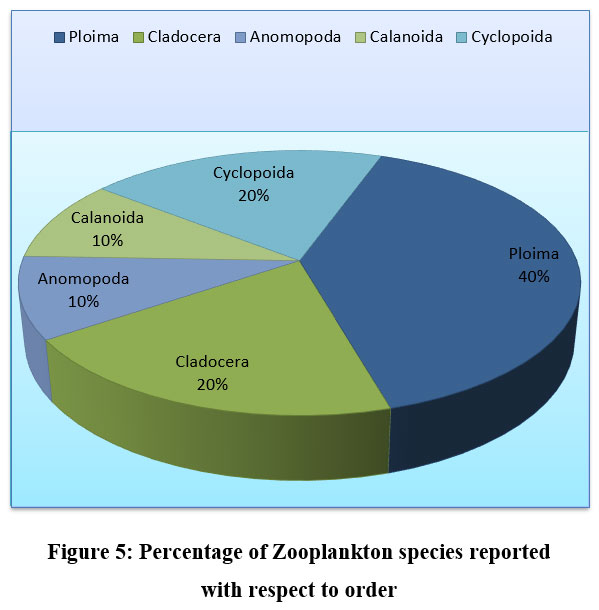 | Figure 5: Percentage of Zooplankton species reported with respect to order
|
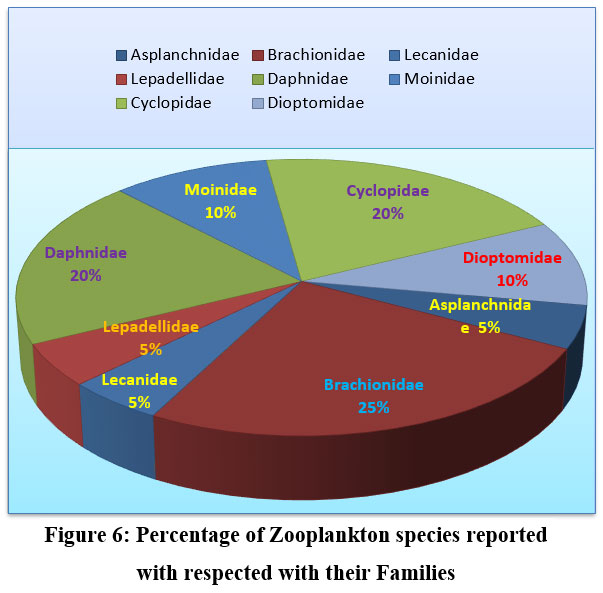 | Figure 6: Percentage of Zooplankton species reported with respected with their Families
|
Table 3: Seasonal Variation of different Groups of Zooplankton
Sl. No | Zooplankton Group | Pre Monsoon | Monsoon | Post Monsoon | Total |
1 | Rotifera (No per Ltr) | 600 | 420 | 300 | 1320 |
2 | Cladocera (No per Ltr) | 390 | 300 | 210 | 900 |
3 | Copepoda (No per Ltr) | 450 | 315 | 200 | 965 |
4 | Total Zooplankton (No per Ltr) | 1440 | 1035 | 710 | 3185 |
Conclusion
As per the findings of this investigation zooplankton diversity is crucial to the health of freshwater ecosystem. Of the 20 zooplankton species that we identified, 8 are Rotifera species, 6 are Cladocera species and 6 are Copepoda species. Seasonally the zooplanktons were maximum in pre monsoon moderate in monsoon and minimum in post monsoon has been observed. This study has determined that the diversity of rotifers is dominant in all the season, followed by Copepoda and Cladocera. Higher number of rotifer species shows that the water body is highly eutrophic The aquatic zooplankton population provided crucial information about available life sources for the growth of fisheries. These days, pollution and human activity are putting biodiversity at risk. Therefore, it is imperative to maintain current knowledge of the richness of all aquatic organisms since biodiversity conservation is concerned.
Acknowledgement
The authors are grateful to the Department of Zoology, Sharnbasva University, Kalaburagi for providing laboratory facilities to carry out the current work.
Funding Sources
The authors received no financial support for the research, authorship or publication of this article.
Conflict of Interest
The authors declare no conflict of interest.
Authors’ Contribution
This work is carried out in collaboration between three authors.
First Author: Siddaram L Poojari – Wrote the first draft of the manuscript and managed analysis of the study.
Second Author: Siddharam Kottalagi - Designed the study and performed the statistical analysis.
Third Author: Chaitra Kollur - Managed the literature and wrote the protocol.
Data Availability Statement
The manuscript incorporates all datasets produced or examined throughout this
research study.
Ethics Approval Statement
The study did not involve an experiment on humans and animals.
References
- Rajagopal, T., Thangamani, A., Sevarkodiyone, S. P., Sekar, M., & Archunan, G. Zooplankton diversity and physico-chemical conditions in three perennial ponds of Virudhunagar district, Tamilnadu. Journal of Environmental Biology.2010; 31(3):265-272.
- Siddaram L, Ramakrishnareddy B, Nagbhushan Reddy, Vijaykumar K. Diversity and abundance of zooplankton in Hattikuni reservoir, Yadgir District, Karnataka. Indian Streams Research Journal. 2016;6(5):01-11.
- Kumar, S., Veerwal, B., & Verma, B. K. Study of Zooplankton to Know Their Role in Determination of Water Quality of Various Water Bodies: A Review. Indian Hydrobiology.2023; 22(1):09-18.
- Swamy HM, Iyyanahalli R. Water Quality status in relation to Zooplankton composition in Lentic Water body of Tarikere taluk of Chikkamagaluru District, Karnataka, India. Applied Aquatic and Terrestrial Eco-Biology. 2022 Mar 5:38-56.
- Shashank KR, Raghunandan KS. A Checklist of Zooplanktons recorded at Melukote Ponds, Pandavapura Taluk, Karnataka. Int J. fisheries and Aquatic studies. 2020;8(3):268-72.
- Basavaraj SK, Kadadevaru GG. Assessment of Physico-chemical Parameters and Zooplankton Community at Gopalaswamy Tank, Chitradurga, Karnataka. Indian Journal of Science and Technology. 2024 Jan 22;17(4):368-72.
CrossRef - Shaik A L, Rao K R, Salunkhe P, Nikam D. Zooplankton Diversity of Ashti Lake, Dist: Solapur (Ms). Bionano Frontier.2014;7(1):118-112.
- Gadekar, G. P.. Diversity of Zooplankton of Pujaritola Lake of Gondia District (MS). Editor Dr. Nurul Fadly Habidin. 2018; 5(3): 1-12.
- Ramalingappa, A., Rajashekar, M., & Vijaykumar, K. Zooplankton diversity in Heroor reservoir, Kalaburagi district, Karnataka. International Research Journal of Emerging Trends in Multidisciplinary.2015; 1(8): 18-31.
- Ramesh PL, Majagi S. Zooplankton diversity in some ponds of Chikkballpur District Karnataka, India. Journal of Applied Science and Research. 2016;4(1):30-7.
- Jayabhaye UM, Madlapure VR. Studies on zooplankton diversity in Parola dam, Hingoli, Maharashtra, India. Journal of Aquatic Biology. 2006;21(2):67-71.
- Michael RG. Studies on the zooplankton of a tropical fish pond. Hydrobiologia. 1968 Aug;32:47-68.
CrossRef - Ramesh I, Kiran B. Assessment of Zooplankton Composition In The Reservoirs of Karnataka: A Review. CIBTech Journal of Zoology. 2019: 8(3):38-46.
- Needham JG, Needham PR. A guide to the study of Fresh Water Biology Holden day Ins. San-Francisco, USA. 1962; 108.
- Pennak RW. Species Composition of Limnetic Zooplankton Communities 1. Limnology and Oceanography. 1957 Jul;2(3):222-32.
CrossRef - Tonapi GT. Fresh water animals of India: An ecological approach.1980.
- Unit CF. Practical guide to identifying freshwater crustacean zooplankton.2004.Cooperative Freshwater Ecology Uni.
- Clesceri, L. S. (1998). Standard methods for examination of water and wastewater. American public health association, 9.
- Mani G, Atul Sharma 2, Mukesh Kumar. Study of Zooplankton Community in a Freshwater Pond in Jammu and Kashmir. Journal of Emerging Technologies and Innovative Research (JETIR. 2023: 3(1): 197-199.
- Rajashekhar M, Vijaykumar K, Paerveen Z. Seasonal variations of zooplankton community in freshwater reservoir Gulbarga District, Karnataka, South India. International Journal of Systems Biology. 2010 Jan 1;2(1):6.
- Khan YI, Nautiyal S, Tikhile P, Sastry V, Bhaskar K. Diversity of Zooplankton and their Seasonal Variations of Gogi Lake, Shahapur taluk, Yadgir district, Karnataka, India.International Research Journal of Environmental Sciences. 2016:5(1):32-38.
- Munde Ashok Sayasrao and More Purushottam Rambhau. Diversity of zooplankton and seasonal variation of density inSukhana Dam, Garkheda Dist Aurangabad (M.S.) India. International Journal of Advanced Research in Biological Sciences. 2020:7(6): 91-97.
- Panpatil P, Deshmukh SV. Study of Zooplankton Diversity in Rajura Dam at Buldhana District of Maharashtra. Journal of Global Biosciences. 2021;10(5):8744-51.
- Anita, S. M., Hatti, S. S., Majagi, S., & Chitra, J. (2019). Assessment of Zooplankton Diversity of Nagaral Dam, Chincholli, Kalaburagi. Research Journal of Life Sciences,Bioinformatics, Pharmaceutical and Chemical Sciences, 5(2), 269-281.
- Anbalagan, R., & Sivakami, R. (2019). Freshwater zooplankton biodiversity and physico-chemical parameters of Mayanur Dam, Tamil Nadu, India. Int. J. Res. Anal. Rev, 6, 85-93.
- Jagadeeshappa, K and Vijayakumara. Studies on Seasonal Variation of Phytoplankton, Zooplankton Diversity and Physicochemical Characteristics in Wetlands of Tiptur Taluk, Tumkur Dist, Karnataka State, India. Journal of Aquatic Biology and Fisheries. 2014:2:203-208.
- Shashank KR, Raghunandan KS. A Checklist of Zooplankton recorded at Melukote Ponds, Pandavapura Taluk, Karnataka. International Journal of fisheries and Aquatic studies. 2020;8(3):268-72.
- Islam MS, Azadi MA, Nasiruddin M, Islam T. Checklist of Zooplankton of the Halda River, Chattogram, Bangladesh. Journal of Bioresource Management. 2022;9(1):11.
- Dabhade DS, Chhaba SG. Zooplankton diversity around washim region of Maharashtra. International journal of advance and innovative research. 2019;6(2):332-6.
- Rao, A. S. K., Salunkhe, P., & Nikam, D. Zooplankton Diversity of Ashti Lake, Dist: Solapur (MS). Bionano Frontier. 2014:7(1): 118-122.
- Mruthyunjaya N B, M. Venkateshwarlu , B. R. Kiran. Distribution and Abundance of Zooplankton in Ayyanakere Lake, Chikmagalur District, Karnataka. International journal for Innovative Research in Multidisciplinary Field. 2016:2(8):72-77.
- Dabas. R.S. Limnological investigations the plnkton of the few lakes of Haryana, and its correlation with physico-chemical factors, primary productivity and fish productivity. Ph.D thesis Merrut University,Merrut..(1980).







